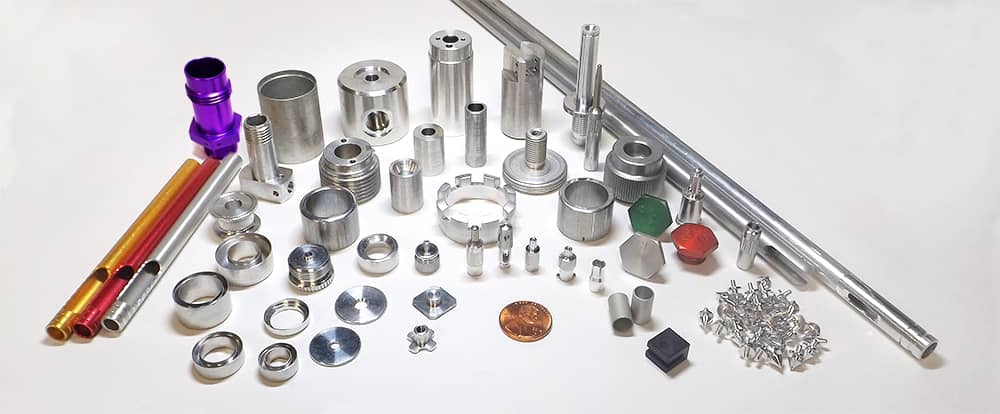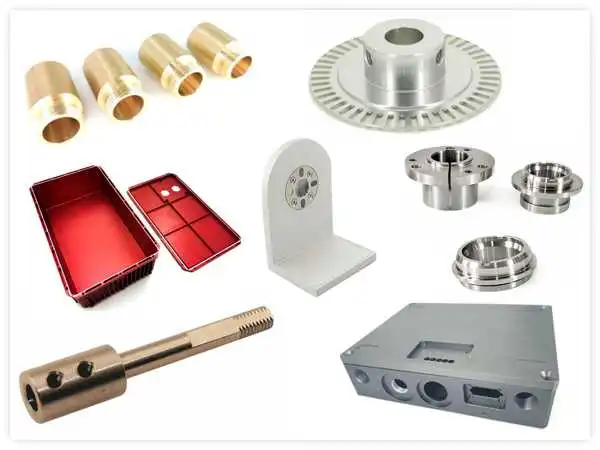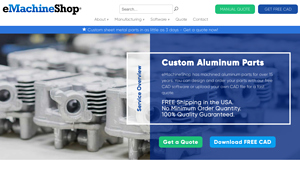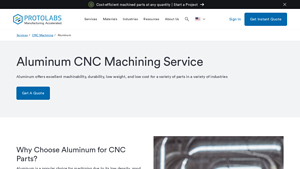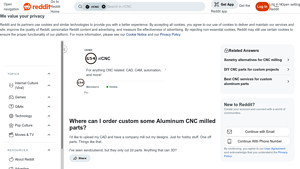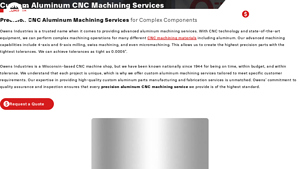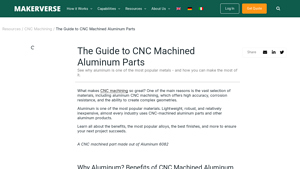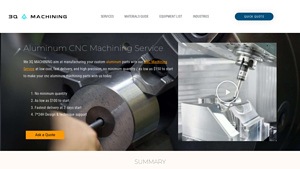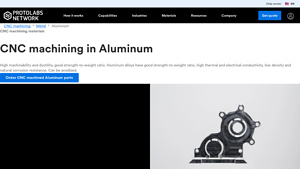Cnc Aluminum Machining Parts Guide: Type, Cost, Top List…
Introduction: Navigating the Global Market for cnc aluminum machining parts
In today’s competitive global marketplace, sourcing high-quality CNC aluminum machining parts can pose a significant challenge for B2B buyers across various industries. With the demand for lightweight, durable materials on the rise, understanding the nuances of aluminum alloys, machining processes, and supplier capabilities is crucial. This comprehensive guide delves into the intricacies of CNC aluminum machining, covering the diverse types of aluminum alloys, their applications in sectors such as automotive, aerospace, and construction, and essential considerations for vetting suppliers.
International buyers, particularly those from Africa, South America, the Middle East, and Europe, will find actionable insights that empower them to make informed purchasing decisions. The guide addresses key factors like cost estimation, quality assurance, and the importance of selecting the right machining processes to meet specific project requirements. By equipping B2B buyers with knowledge on material properties and machining techniques, this resource aims to streamline the sourcing process and enhance operational efficiency.
Navigating the complexities of CNC aluminum machining parts doesn’t have to be daunting. With the right information at your fingertips, you can confidently partner with suppliers that align with your business goals and ensure the successful execution of your projects.
Understanding cnc aluminum machining parts Types and Variations
| Type Name | Key Distinguishing Features | Primary B2B Applications | Brief Pros & Cons for Buyers |
|---|---|---|---|
| CNC Milling Parts | Complex 3D shapes, tight tolerances | Aerospace, automotive, custom machinery | Pros: High precision; Cons: Longer lead times |
| CNC Turning Parts | Cylindrical shapes, efficient material removal | Automotive components, medical devices | Pros: Quick production; Cons: Limited shapes |
| Aluminum Extrusions | Long shapes with consistent cross-section | Construction, furniture, architectural components | Pros: Versatile; Cons: Requires tooling |
| Laser Cut Parts | Precise 2D shapes, smooth edges | Signage, electronic enclosures, prototypes | Pros: Fast prototyping; Cons: Thickness limits |
| Waterjet Cut Parts | Versatile cutting through thick materials without heat | Aerospace, automotive, custom fabrication | Pros: No thermal distortion; Cons: Slower speed |
What Are the Characteristics of CNC Milling Parts?
CNC milling parts are distinguished by their ability to create complex three-dimensional shapes with high precision. This process involves rotating cutting tools that remove material from a solid block of aluminum, allowing for intricate designs with tight tolerances. Commonly used in industries such as aerospace and automotive, these parts are essential for applications requiring high accuracy and reliability. When considering purchasing CNC milling parts, buyers should evaluate the complexity of their designs, required tolerances, and the lead times involved in production.
How Do CNC Turning Parts Differ from Other Types?
CNC turning parts are primarily characterized by their cylindrical shapes, produced by rotating the workpiece against stationary cutting tools. This method is highly efficient for producing parts with symmetrical profiles, making it ideal for components like shafts, pins, and bushings used in automotive and medical applications. Buyers should consider the dimensions and specifications of the parts they need, as well as the potential for rapid production cycles, which can significantly reduce time to market.
What Are the Advantages of Aluminum Extrusions?
Aluminum extrusions are unique in that they involve shaping aluminum into long sections with a consistent cross-section. This method is particularly beneficial for applications in construction and furniture, where long, lightweight components are essential. Extruded parts can be easily integrated into various designs, providing versatility for manufacturers. Buyers should assess the specific profiles they need and the potential for customized solutions, while also considering tooling costs associated with extrusion processes.
Why Choose Laser Cut Parts for Your Projects?
Laser cut parts are known for their ability to produce precise two-dimensional shapes with smooth edges, making them ideal for applications in signage, electronic enclosures, and prototypes. The laser cutting process allows for rapid production and high accuracy, which is particularly useful for short runs or custom designs. Buyers should evaluate their material thickness requirements and the speed of production, as well as the potential for post-processing needs, to ensure optimal results for their projects.
What Makes Waterjet Cut Parts a Viable Option?
Waterjet cut parts utilize high-pressure water streams mixed with abrasives to cut through thick materials without introducing thermal distortion. This method is particularly suited for industries such as aerospace and automotive, where material integrity is crucial. Waterjet cutting is versatile and can handle a variety of materials, but buyers should be aware that it may have slower cutting speeds compared to other methods. Evaluating the material types and thicknesses required for specific applications will help buyers determine if this method aligns with their project needs.
Key Industrial Applications of cnc aluminum machining parts
| Industry/Sector | Specific Application of CNC Aluminum Machining Parts | Value/Benefit for the Business | Key Sourcing Considerations for this Application |
|---|---|---|---|
| Aerospace | Aircraft Components (wings, fuselages) | Reduces weight, improves fuel efficiency, enhances performance | High precision, compliance with aviation standards, timely delivery |
| Automotive | Engine Blocks and Transmission Housings | Lightweight, improves fuel efficiency, reduces emissions | Material certifications, stringent tolerances, rapid prototyping capabilities |
| Electronics | Enclosures for Electronic Devices | Protects components, enhances thermal management | Customization options, surface finishing requirements, heat dissipation properties |
| Construction | Structural Components for Buildings | Durable, corrosion-resistant, lightweight construction materials | Local regulations, environmental considerations, bulk ordering capabilities |
| Marine | Boat Hulls and Structural Parts | Corrosion resistance in harsh environments, lightweight design | Material grades for saltwater resistance, design flexibility, lead times |
How Are CNC Aluminum Machining Parts Used in Aerospace Applications?
In the aerospace industry, CNC aluminum machining parts are crucial for manufacturing components such as wings and fuselages. The lightweight nature of aluminum significantly enhances fuel efficiency and performance, making it an ideal choice for aircraft. International B2B buyers must consider compliance with strict aviation standards and precise machining tolerances to ensure safety and reliability. Timely delivery is also essential to meet production schedules and avoid costly delays.
What Role Do CNC Aluminum Machining Parts Play in Automotive Manufacturing?
CNC aluminum machining parts are widely used in automotive applications, particularly for engine blocks and transmission housings. The lightweight properties of aluminum contribute to improved fuel efficiency and reduced emissions, aligning with global sustainability goals. Buyers should prioritize suppliers who can provide material certifications and adhere to stringent tolerances to ensure optimal performance. Additionally, rapid prototyping capabilities can accelerate the development of innovative automotive designs.
How Are CNC Aluminum Machining Parts Applied in the Electronics Sector?
In the electronics sector, CNC aluminum machining parts are employed to create enclosures for various devices, protecting sensitive components while also enhancing thermal management. The ability to customize designs allows manufacturers to meet specific product requirements. B2B buyers should focus on suppliers that offer a range of surface finishing options to improve aesthetics and functionality, as well as those that understand heat dissipation properties critical for electronic performance.
What Are the Benefits of Using CNC Aluminum Machining Parts in Construction?
CNC aluminum machining parts are increasingly utilized in the construction industry for structural components. Their durability and corrosion resistance make them suitable for both new buildings and renovations, particularly in regions prone to harsh weather. Buyers must consider local regulations regarding building materials and environmental impact, as well as the capacity for bulk orders to meet large-scale construction needs. The lightweight nature of aluminum also facilitates easier handling and installation.
How Do CNC Aluminum Machining Parts Enhance Marine Applications?
In marine applications, CNC aluminum machining parts are essential for producing boat hulls and structural components that withstand harsh marine environments. The corrosion-resistant properties of aluminum ensure longevity and reliability in saltwater conditions. B2B buyers should look for suppliers that offer specific material grades for saltwater resistance and flexibility in design to accommodate various vessel types. Lead times are critical, as projects often depend on timely delivery to adhere to launch schedules.
3 Common User Pain Points for ‘cnc aluminum machining parts’ & Their Solutions
Scenario 1: Navigating Quality Control Challenges in CNC Aluminum Machining Parts
The Problem: B2B buyers often face significant challenges related to quality assurance when sourcing CNC aluminum machining parts. Variability in machining precision, surface finish, and material properties can lead to parts that do not meet specifications. This issue is particularly critical for industries such as aerospace and automotive, where precision is paramount. A supplier’s failure to meet quality standards can result in costly production delays, increased waste, and ultimately, compromised safety and performance in final products.
The Solution: To mitigate quality control issues, buyers should establish a rigorous supplier selection process that emphasizes certifications and quality management systems. Look for suppliers with ISO 9001 certification or similar quality assurance protocols. Additionally, request detailed documentation of material certifications and machining processes. Implement a robust communication strategy to clearly outline specifications, tolerances, and quality expectations from the outset. Regularly scheduled audits and inspections can further ensure adherence to standards. Utilizing advanced technologies such as 3D CAD simulations can help visualize the final product and identify potential issues before production begins, minimizing the risk of errors and ensuring consistent quality.
Scenario 2: Managing Lead Times and Delivery Schedules for CNC Machined Parts
The Problem: In today’s fast-paced market, B2B buyers often struggle with extended lead times and unpredictable delivery schedules for CNC aluminum machining parts. Delays can disrupt production timelines and affect the overall project delivery, leading to lost business opportunities and strained client relationships. This problem is exacerbated when sourcing parts from international suppliers, where factors such as customs clearance, shipping delays, and time zone differences complicate communication and coordination.
The Solution: To manage lead times effectively, buyers should prioritize establishing relationships with suppliers that offer expedited services and transparent communication regarding production timelines. Utilize suppliers that provide real-time tracking of orders and proactive updates on any potential delays. Consider implementing a Just-In-Time (JIT) inventory system to align part delivery with production schedules, thereby reducing holding costs and mitigating the impact of delays. Additionally, diversifying the supplier base by sourcing from multiple regions can provide flexibility and backup options in case of unforeseen disruptions, ensuring a more reliable supply chain.
Scenario 3: Overcoming Cost Constraints in CNC Aluminum Machining Projects
The Problem: Cost management is a persistent challenge for B2B buyers involved in CNC aluminum machining projects. Fluctuations in material prices, machining costs, and unforeseen expenses can strain budgets, particularly for projects with tight margins. Buyers may find themselves facing unexpected costs due to changes in material specifications or machining requirements, which can lead to project overruns and impact profitability.
The Solution: To navigate cost constraints effectively, buyers should engage in thorough upfront planning and budgeting. Conduct a comprehensive analysis of material costs and machining processes to identify areas for potential savings. Consider negotiating long-term contracts with suppliers to lock in prices and reduce the risk of future price increases. Additionally, leveraging technology for design optimization can minimize material waste and machining time, translating to lower costs. Using advanced software tools to analyze the manufacturing process can help identify cost-saving opportunities, allowing for adjustments in design or production techniques without compromising quality. Regularly reviewing supplier performance and cost structures can also help buyers maintain competitive pricing and ensure value for their investment.
Strategic Material Selection Guide for cnc aluminum machining parts
What Are the Key Properties of Common Aluminum Alloys for CNC Machining?
When selecting materials for CNC aluminum machining parts, understanding the properties of various aluminum alloys is critical. Each alloy offers unique characteristics that can significantly influence the performance, durability, and cost-effectiveness of the final product. Below, we analyze four commonly used aluminum alloys in CNC machining, focusing on their properties, advantages, disadvantages, and specific considerations for international buyers.
How Does Aluminum 6061 Stand Out in CNC Machining Applications?
Aluminum 6061 is one of the most versatile and widely used aluminum alloys in CNC machining. It boasts excellent mechanical properties, including good corrosion resistance and weldability, making it suitable for a range of applications, from automotive to aerospace components. Its temperature rating allows it to perform well in moderate to high-stress environments.
Pros: The alloy is easy to machine and has a good strength-to-weight ratio, making it ideal for lightweight structural components. Additionally, its availability in various forms (sheets, plates, bars) enhances its usability.
Cons: While it offers good corrosion resistance, it is not as resistant as some other alloys, such as 5052. The cost can also be higher compared to more basic aluminum alloys.
Impact on Application: Aluminum 6061 is often used in environments where weight savings are crucial, such as in aircraft fittings and automotive parts. Its moderate corrosion resistance makes it suitable for applications in both coastal and inland areas.
Considerations for International Buyers: Buyers from regions like Europe and the Middle East should ensure compliance with relevant standards such as ASTM and EN. The availability of this alloy is generally high, but logistics can vary, especially in remote areas.
What Makes Aluminum 5052 a Preferred Choice for Marine Applications?
Aluminum 5052 is known for its exceptional corrosion resistance, particularly in marine environments. This alloy is primarily alloyed with magnesium, which contributes to its excellent formability and weldability.
Pros: Its high resistance to corrosion makes it ideal for marine applications, such as boat hulls and fuel tanks. It is also relatively easy to machine and can be formed into complex shapes.
Cons: The main drawback is that it cannot be heat-treated to enhance strength, which may limit its use in high-stress applications. Additionally, it is more expensive than some other alloys.
Impact on Application: Given its properties, 5052 is often used in applications exposed to harsh environments, such as coastal regions or chemical processing plants.
Considerations for International Buyers: Compliance with marine standards is essential for buyers in regions like South America and Africa, where marine applications are prevalent. Understanding local regulations and certifications can facilitate smoother transactions.
Why Is Aluminum 7075 Considered a High-Performance Option?
Aluminum 7075 is one of the strongest aluminum alloys available, primarily used in aerospace and military applications. Its high strength-to-weight ratio makes it ideal for components that undergo significant stress and fatigue.
Pros: The alloy’s strength allows for thinner components, resulting in weight savings. It is also highly machinable, which can reduce manufacturing costs.
Cons: However, 7075 has poor corrosion resistance compared to other alloys, which may necessitate additional surface treatments. It is also one of the more expensive aluminum alloys.
Impact on Application: This alloy is often used in applications such as aircraft wings and high-stress structural components.
Considerations for International Buyers: Buyers in the aerospace sector must ensure compliance with stringent industry standards, such as those set by ASTM and JIS. The cost may be a consideration for budget-sensitive projects, particularly in developing regions.
How Does Aluminum 2024 Fit into the CNC Machining Landscape?
Aluminum 2024 is known for its high fatigue resistance and is commonly used in aerospace applications. However, it is not as corrosion-resistant as other alloys, making it necessary to apply protective coatings in certain environments.
Pros: Its high strength and good machinability make it suitable for applications where weight savings and durability are critical.
Cons: The alloy’s poor weldability and corrosion resistance can limit its applications, especially in harsh environments.
Impact on Application: Aluminum 2024 is often used in aircraft structures and components that experience cyclic loading.
Considerations for International Buyers: Buyers should be aware of the need for protective treatments to enhance corrosion resistance, particularly in humid or coastal environments.
Summary Table of Common Aluminum Alloys for CNC Machining
| Material | Typical Use Case for CNC Aluminum Machining Parts | Key Advantage | Key Disadvantage/Limitation | Relative Cost (Low/Med/High) |
|---|---|---|---|---|
| Aluminum 6061 | Automotive and aerospace components | Excellent machinability and weldability | Moderate corrosion resistance | Medium |
| Aluminum 5052 | Marine applications and fuel tanks | Exceptional corrosion resistance | Cannot be heat-treated | High |
| Aluminum 7075 | Aerospace and military components | High strength-to-weight ratio | Poor corrosion resistance | High |
| Aluminum 2024 | Aircraft structures and components | High fatigue resistance | Poor weldability and corrosion resistance | Medium |
This strategic material selection guide provides valuable insights for international B2B buyers, enabling informed decisions on aluminum alloys for CNC machining parts, tailored to specific application needs and regional considerations.
In-depth Look: Manufacturing Processes and Quality Assurance for cnc aluminum machining parts
What Are the Main Stages of Manufacturing CNC Aluminum Machining Parts?
Manufacturing CNC aluminum machining parts involves several critical stages that ensure precision, quality, and efficiency. The primary stages include material preparation, forming, assembly, and finishing.
How Is Material Prepared for CNC Aluminum Machining?
The first step in the manufacturing process is material preparation. This involves selecting the appropriate aluminum alloy based on the desired properties of the final product. Commonly used alloys include 6061 for general purposes, 5052 for excellent corrosion resistance, and 7075 for high strength applications.
Once the alloy is selected, it is cut into manageable sizes, often in the form of sheets, bars, or blocks. The material is then inspected for defects such as cracks or inclusions, ensuring that only high-quality raw materials are used. This initial quality check helps prevent issues later in the machining process.
What Forming Techniques Are Employed in CNC Aluminum Machining?
The forming stage is where CNC machining technology comes into play. Using Computer Numerical Control (CNC) machines, manufacturers can achieve intricate shapes and precise dimensions. Key techniques include:
- CNC Milling: This process involves rotating cutting tools that remove material from the workpiece, allowing for the creation of complex 3D shapes.
- CNC Turning: This technique is utilized to create cylindrical parts by feeding cutting tools into rotating material.
- Waterjet Cutting: A high-pressure stream of water, often mixed with abrasives, is used to cut materials into 2D shapes with clean edges.
- EDM (Electrical Discharge Machining): This method employs electrical sparks to erode material, making it ideal for intricate designs.
Each of these techniques requires precise programming and setup to ensure that tolerances are maintained throughout the manufacturing process.
How Is Assembly Conducted in the CNC Aluminum Machining Process?
In many cases, CNC aluminum parts may need to be assembled with other components. The assembly stage involves the integration of various machined parts, which may include fastening, welding, or other joining techniques. This process also requires stringent alignment and fit checks to ensure that the assembled product meets design specifications.
Using jigs and fixtures can enhance accuracy during assembly, reducing the likelihood of errors. It is essential to document this stage, as it may affect the overall quality of the final product.
What Finishing Techniques Are Applied to CNC Aluminum Machining Parts?
Finishing is the final stage of manufacturing, where parts undergo processes to enhance their surface quality and functionality. Common finishing techniques include:
- Anodizing: This electrochemical process increases corrosion resistance and surface hardness while allowing for color customization.
- Powder Coating: A dry finishing process that provides a durable and aesthetically pleasing surface.
- Polishing and Plating: These techniques enhance the appearance and provide additional protection against wear and corrosion.
Effective finishing not only improves the visual appeal of the parts but also extends their lifespan and functionality.
What Quality Assurance Practices Are Essential for CNC Aluminum Machining?
Quality assurance (QA) is a critical aspect of the CNC aluminum machining process, ensuring that products meet international standards and customer specifications.
Which International Standards Should B2B Buyers Consider?
For international buyers, understanding quality assurance standards is vital. Commonly recognized standards include:
- ISO 9001: A global standard for quality management systems that ensures consistent quality in products and services.
- CE Marking: Required for products sold in the European Economic Area, indicating compliance with safety and health standards.
- API Standards: Particularly relevant for the oil and gas industry, API standards ensure quality in the manufacturing of components used in these sectors.
These certifications demonstrate a supplier’s commitment to quality and can significantly influence purchasing decisions.
What Are the Key Quality Control Checkpoints in CNC Aluminum Machining?
Quality control (QC) involves various checkpoints throughout the manufacturing process, including:
- Incoming Quality Control (IQC): Inspection of raw materials upon arrival to ensure they meet specifications.
- In-Process Quality Control (IPQC): Ongoing checks during the manufacturing process to monitor tolerances and identify any deviations early.
- Final Quality Control (FQC): A thorough inspection of the finished products before shipment, ensuring that they meet all requirements.
Implementing these checkpoints helps maintain high-quality standards and reduces the risk of defects.
How Can B2B Buyers Verify Supplier Quality Control?
B2B buyers should actively verify a supplier’s quality control practices to ensure reliability. Effective methods include:
- Audits: Conducting regular audits of suppliers to assess their quality management systems and adherence to standards.
- Quality Reports: Requesting detailed QC reports that outline testing results and compliance with specifications.
- Third-Party Inspections: Engaging independent inspectors to evaluate the manufacturing process and product quality, providing an unbiased assessment.
These steps not only foster transparency but also help in building trust between buyers and suppliers.
What Testing Methods Are Commonly Used in CNC Aluminum Machining Quality Assurance?
Testing methods play a vital role in ensuring that CNC aluminum parts meet the necessary performance and safety standards. Common testing methods include:
- Dimensional Inspection: Using calipers, gauges, and coordinate measuring machines (CMM) to verify that parts meet specified dimensions.
- Tensile Testing: Evaluating the strength and ductility of aluminum alloys under stress to ensure they can withstand operational conditions.
- Non-Destructive Testing (NDT): Techniques such as ultrasonic testing or X-ray inspection help identify internal defects without damaging the parts.
By employing these testing methods, manufacturers can ensure that their products are not only compliant but also reliable in their intended applications.
How Do Quality Control Nuances Affect International B2B Buyers?
International B2B buyers, particularly from regions like Africa, South America, the Middle East, and Europe, must navigate various quality control nuances. These may include:
- Regulatory Compliance: Understanding and complying with local regulations and standards in the buyer’s region.
- Cultural Considerations: Different regions may have varying expectations regarding quality and delivery, necessitating clear communication and documentation.
- Supply Chain Transparency: Ensuring that suppliers maintain transparency throughout the supply chain, which can impact quality and delivery times.
By addressing these nuances, buyers can make informed decisions and foster successful long-term relationships with their suppliers.
Conclusion
A comprehensive understanding of the manufacturing processes and quality assurance practices for CNC aluminum machining parts is essential for B2B buyers. By focusing on material preparation, forming, assembly, and finishing, along with robust quality control measures, buyers can ensure they receive high-quality products that meet their specific needs. Engaging with suppliers who prioritize these processes and standards will lead to successful procurement and long-lasting partnerships.
Practical Sourcing Guide: A Step-by-Step Checklist for ‘cnc aluminum machining parts’
To effectively procure CNC aluminum machining parts, it’s essential to follow a structured approach that ensures quality, cost-effectiveness, and timely delivery. This checklist will guide you through the critical steps to streamline your sourcing process.
Step 1: Define Your Technical Specifications
Clearly outline the technical specifications of the CNC aluminum parts you require. This includes dimensions, tolerances, surface finish, and material grade. By having a detailed specification, you can ensure that suppliers understand your exact requirements, which reduces the risk of miscommunication and errors in production.
- Considerations: Include details such as alloy type (e.g., 6061, 7075) and any specific machining processes needed (e.g., CNC milling or turning).
Step 2: Research Potential Suppliers
Conduct thorough research to identify potential suppliers who specialize in CNC aluminum machining. Look for manufacturers with experience in your specific industry and those who can demonstrate a solid track record of quality and reliability.
- Where to Look: Utilize online marketplaces, industry directories, and trade shows. Pay attention to supplier reviews and ratings.
Step 3: Evaluate Supplier Certifications
Before engaging with suppliers, verify their certifications and quality management systems. Certifications such as ISO 9001 or AS9100 indicate adherence to international quality standards, which is crucial for ensuring consistent product quality.
- Verification: Request copies of certifications and inspect their quality control processes, including material traceability and inspection methods.
Step 4: Request Samples
Once you have shortlisted suppliers, request samples of their work. This will allow you to assess the quality of their machining, surface finish, and overall craftsmanship before placing a larger order.
- What to Look For: Evaluate the samples against your specifications, paying attention to tolerances, finishes, and any defects.
Step 5: Discuss Pricing and Payment Terms
Engage in discussions regarding pricing, payment terms, and bulk order discounts. Understanding the total cost of ownership, including shipping and any potential duties, is critical for budget planning.
- Negotiation Tips: Be prepared to negotiate, and consider the total value rather than just the price per unit. Factor in reliability and quality as part of the overall cost.
Step 6: Confirm Lead Times and Delivery Options
Clarify lead times and delivery options to ensure that the supplier can meet your production schedule. Timely delivery is essential for maintaining your project timelines and avoiding costly delays.
- Ask Questions: Inquire about their production capacity and how they handle rush orders or unexpected delays.
Step 7: Establish a Communication Plan
Finally, set up a clear communication plan with your selected supplier. Regular updates and open lines of communication can prevent misunderstandings and keep the project on track.
- Best Practices: Use tools like project management software or regular status calls to monitor progress and address any issues promptly.
By following this checklist, you can ensure a more efficient and effective sourcing process for CNC aluminum machining parts, leading to successful project outcomes and long-term supplier relationships.
Comprehensive Cost and Pricing Analysis for cnc aluminum machining parts Sourcing
What Are the Key Cost Components for CNC Aluminum Machining Parts?
Understanding the cost structure of CNC aluminum machining parts is crucial for B2B buyers. The primary cost components include:
-
Materials: The choice of aluminum alloy significantly impacts the cost. Common alloys like 6061 and 5052 are generally more affordable, while high-strength options such as 7075 and 7050 come at a premium. The market price of aluminum fluctuates based on global demand and supply dynamics.
-
Labor: Skilled labor is essential for precise machining. Labor costs vary by region; for example, labor is often less expensive in parts of South America and Africa compared to Europe. The complexity of the design can also affect labor hours and costs.
-
Manufacturing Overhead: This includes costs related to facility maintenance, utilities, and administrative expenses. Overhead can vary significantly between suppliers, with larger manufacturers often achieving economies of scale.
-
Tooling: Custom tooling may be required for specific designs, which adds to initial costs. However, these costs can be amortized over larger production runs, making them less significant on a per-unit basis.
-
Quality Control (QC): Ensuring that parts meet specifications involves additional QC processes, which can add to overall costs. Certifications like ISO can enhance product reliability but may also increase costs.
-
Logistics: Shipping costs are a critical consideration, especially for international buyers. Factors such as distance, weight, and shipping methods (air vs. sea) influence logistics costs. Buyers should factor in potential customs duties and tariffs.
-
Margin: Suppliers typically add a margin to cover risk and ensure profit. This margin can vary based on competition, demand, and the supplier’s reputation.
How Do Price Influencers Affect CNC Aluminum Machining Costs?
Several factors influence the pricing of CNC aluminum machining parts:
-
Volume and Minimum Order Quantity (MOQ): Larger orders generally lead to lower per-unit costs due to economies of scale. Conversely, small orders may incur higher prices due to fixed costs being spread over fewer units.
-
Specifications and Customization: Custom designs require more intricate machining processes, which can significantly increase costs. Providing detailed specifications can help suppliers offer more accurate quotes.
-
Material Selection: The choice of alloy affects not only the material cost but also the machining process, impacting labor and overhead costs. Buyers should weigh the benefits of high-performance alloys against their cost.
-
Quality and Certifications: Parts requiring higher quality standards or specific certifications can be more expensive. Understanding the necessary quality levels for your application can help avoid overspending.
-
Supplier Factors: Supplier location, reputation, and capabilities can influence pricing. Establishing relationships with reliable suppliers can lead to better pricing and terms.
-
Incoterms: The chosen Incoterms (International Commercial Terms) affect the total cost of ownership. Incoterms define the responsibilities of buyers and sellers regarding shipping, insurance, and tariffs, impacting overall costs.
What Are the Best Practices for Negotiating CNC Aluminum Machining Prices?
When engaging with suppliers, consider these tips for effective negotiation:
-
Leverage Volume: If possible, consolidate orders to increase volume, which can lead to discounts. Suppliers are often more willing to negotiate on larger orders.
-
Communicate Clearly: Provide detailed specifications and requirements to avoid misunderstandings that can lead to increased costs. Clear communication helps suppliers provide more accurate quotes.
-
Evaluate Total Cost of Ownership (TCO): Look beyond the initial price and consider logistics, QC, and potential rework costs. A lower upfront price may not always be the most cost-effective option.
-
Understand Pricing Nuances: Be aware of seasonal fluctuations in material prices and how they affect quotes. Timing your order can lead to significant savings.
-
Build Relationships: Establishing long-term relationships with suppliers can lead to better pricing and terms. Trust and reliability can often result in favorable conditions over time.
Conclusion
B2B buyers sourcing CNC aluminum machining parts must navigate a complex landscape of costs and pricing influences. Understanding the cost components and negotiating effectively can lead to significant savings, particularly for international buyers in regions such as Africa, South America, the Middle East, and Europe. Always remember to account for indicative pricing and seek multiple quotes to ensure competitive pricing.
Alternatives Analysis: Comparing cnc aluminum machining parts With Other Solutions
Understanding the Alternatives to CNC Aluminum Machining Parts
When it comes to sourcing components for manufacturing, CNC aluminum machining parts are a popular choice due to their lightweight, strength, and versatility. However, various alternative solutions exist that may better suit specific applications or budgets. This analysis will compare CNC aluminum machining parts against two viable alternatives: 3D printing with polymers and traditional metal stamping.
Comparison of CNC Aluminum Machining Parts with Alternatives
| Comparison Aspect | CNC Aluminum Machining Parts | 3D Printing with Polymers | Traditional Metal Stamping |
|---|---|---|---|
| Performance | High precision and durability | Good for prototypes, less durable | High volume efficiency, durable |
| Cost | Moderate to high | Low to moderate for small runs | Low per unit in high volumes |
| Ease of Implementation | Requires CAD design and setup | Simple setup, but limited materials | Requires tooling setup, complex for small runs |
| Maintenance | Low, depending on machine use | Low, but printers may require calibration | Moderate, tooling wear can occur |
| Best Use Case | Aerospace, automotive, high-stress applications | Prototyping, custom designs, low-stress applications | High-volume production of uniform parts |
In-Depth Analysis of Alternatives
3D Printing with Polymers
3D printing is an innovative manufacturing method that builds objects layer by layer from a digital model. This process is highly flexible and allows for rapid prototyping, making it ideal for custom designs and low-volume production. While the initial setup is relatively straightforward, the material choices are generally limited to polymers, which may not offer the same strength and durability as aluminum. As a result, 3D printing is best suited for applications where weight is less critical, such as consumer products or non-structural components.
Traditional Metal Stamping
Metal stamping is a well-established manufacturing process that involves using dies to cut and shape metal sheets into desired forms. This method excels in high-volume production settings, delivering uniform parts at a lower per-unit cost compared to CNC machining. However, the initial tooling investment is significant, and it may not be economically viable for small production runs. Metal stamping is particularly advantageous for applications requiring high durability and consistency, such as automotive body parts and appliance components.
Making the Right Choice for Your Manufacturing Needs
Selecting the appropriate manufacturing solution depends on various factors, including the specific application, production volume, and budget constraints. CNC aluminum machining parts are ideal for projects requiring high precision and strength, particularly in aerospace and automotive sectors. If rapid prototyping or custom designs are needed, 3D printing may be the best option. Conversely, for high-volume production of standard components, traditional metal stamping can provide an efficient and cost-effective solution.
B2B buyers should evaluate their project requirements, including material properties, production timelines, and cost implications, to determine which manufacturing method aligns best with their operational goals. Understanding these alternatives will empower businesses to make informed decisions that enhance their manufacturing capabilities and overall competitiveness.
Essential Technical Properties and Trade Terminology for cnc aluminum machining parts
What Are the Key Technical Properties of CNC Aluminum Machining Parts?
Understanding the technical properties of CNC aluminum machining parts is crucial for B2B buyers, especially when selecting materials for manufacturing processes. Here are some essential specifications:
1. Material Grade
The grade of aluminum significantly affects its mechanical properties and suitability for specific applications. Common grades include 6061, 5052, and 7075. Each grade offers different strengths, corrosion resistance, and machinability. For instance, 6061 is versatile and easy to weld, making it ideal for a variety of applications, while 7075 is known for its high strength, often used in aerospace components. Selecting the right grade ensures optimal performance and longevity of the final product.
2. Tolerance
Tolerance refers to the permissible limits of variation in a physical dimension. In CNC machining, achieving precise tolerances is critical for ensuring parts fit together correctly, particularly in high-stakes industries like aerospace and automotive. Tighter tolerances can lead to higher costs due to increased machining time and specialized equipment, so understanding the balance between required precision and cost is essential for B2B buyers.
3. Surface Finish
The surface finish of aluminum parts affects both aesthetics and functionality. Options range from anodizing, which enhances corrosion resistance, to polishing for a mirror-like appearance. Different finishes can also influence the part’s performance in specific environments, such as marine applications where exposure to saltwater is a concern. Buyers should consider the end-use of the part when selecting a surface finish to ensure it meets operational demands.
4. Weight
Aluminum’s lightweight nature is one of its most significant advantages, especially in industries focused on reducing energy consumption and enhancing efficiency. Understanding the weight specifications of parts can help in optimizing design and ensuring compliance with weight-related regulations in transportation and aerospace sectors.
5. Strength-to-Weight Ratio
The strength-to-weight ratio is a critical performance metric for aluminum components. This property quantifies how much strength a material can provide relative to its weight. In applications where weight savings are paramount, such as in aircraft or automotive design, selecting materials with an optimal strength-to-weight ratio can lead to improved fuel efficiency and performance.
What Are Common Trade Terms in CNC Aluminum Machining?
Familiarity with industry jargon is vital for effective communication between buyers and suppliers. Here are some common terms:
1. OEM (Original Equipment Manufacturer)
An OEM is a company that produces parts or equipment that may be marketed by another manufacturer. In CNC machining, understanding the relationship between OEMs and suppliers can help buyers streamline their sourcing processes and ensure they receive quality parts that meet their specifications.
2. MOQ (Minimum Order Quantity)
MOQ refers to the smallest quantity of a product that a supplier is willing to sell. This term is essential for budget-conscious buyers, as ordering below the MOQ can lead to higher costs per unit or the inability to place an order altogether. Understanding MOQ helps buyers plan their purchases and manage inventory effectively.
3. RFQ (Request for Quotation)
An RFQ is a formal process by which buyers solicit quotes from suppliers for specific products or services. This process is vital for obtaining competitive pricing and evaluating potential suppliers. A well-crafted RFQ can streamline the procurement process and ensure that all necessary specifications are clearly communicated.
4. Incoterms (International Commercial Terms)
Incoterms are standardized international trade terms that define the responsibilities of buyers and sellers regarding shipping, insurance, and tariffs. Knowledge of these terms is crucial for B2B buyers to avoid misunderstandings about shipping costs and responsibilities, especially in international transactions.
5. Secondary Operations
Secondary operations refer to additional processes that may be required after the initial CNC machining, such as bending, tapping, or surface finishing. Understanding these operations helps buyers anticipate total project costs and timelines, ensuring they can meet their production schedules.
By grasping these technical properties and trade terms, B2B buyers can make informed decisions, optimize their supply chain, and enhance their operational efficiency in sourcing CNC aluminum machining parts.
Navigating Market Dynamics and Sourcing Trends in the cnc aluminum machining parts Sector
What Are the Current Market Trends Impacting CNC Aluminum Machining Parts?
The CNC aluminum machining parts sector is experiencing a dynamic transformation driven by various global factors. The rise in demand for lightweight materials in industries such as aerospace, automotive, and construction is a primary driver. Companies are increasingly looking for efficient manufacturing processes that can deliver high-quality parts with minimal waste. Emerging technologies like additive manufacturing and advanced CNC machining are enhancing production capabilities, allowing for complex geometries that were previously difficult to achieve.
In regions such as Africa, South America, the Middle East, and Europe, international buyers are increasingly focused on sourcing from suppliers that offer rapid prototyping and low-volume production capabilities. This trend is particularly evident in markets like Brazil and Saudi Arabia, where local industries are seeking to reduce lead times and costs through streamlined sourcing strategies. Additionally, the integration of Industry 4.0 principles—such as IoT and data analytics—into the manufacturing process is allowing companies to optimize operations and improve supply chain transparency.
Moreover, as businesses become more globalized, they face challenges such as fluctuating material costs and geopolitical uncertainties. Buyers must remain agile, leveraging data-driven insights to navigate these market dynamics effectively. Understanding regional market conditions and regulatory environments will be crucial for international buyers to make informed sourcing decisions.
How Is Sustainability Shaping the CNC Aluminum Machining Parts Supply Chain?
Sustainability is becoming a pivotal factor in the sourcing of CNC aluminum machining parts. The environmental impact of manufacturing processes is under increased scrutiny, pushing companies to adopt more sustainable practices. This includes not only the use of recyclable materials but also the implementation of energy-efficient production methods. Buyers are now prioritizing suppliers who demonstrate a commitment to reducing their carbon footprint and waste.
Ethical sourcing is equally important, with businesses increasingly evaluating their supply chains for transparency and responsibility. Certifications such as ISO 14001 for environmental management and LEED for sustainable building practices are becoming key indicators of a supplier’s commitment to ethical standards. For international buyers, particularly in regions like Europe and North America, these certifications can serve as a benchmark for evaluating potential partners.
The use of ‘green’ materials, such as recycled aluminum, is also gaining traction. Aluminum is inherently recyclable, and sourcing from suppliers who utilize recycled content can significantly lower the environmental impact of products. As sustainability becomes a core value for many companies, aligning sourcing strategies with these principles will not only enhance brand reputation but also meet the growing consumer demand for environmentally responsible products.
What Is the Historical Context of CNC Aluminum Machining Parts Development?
The evolution of CNC aluminum machining parts can be traced back to the industrial revolution when aluminum was first introduced as a viable material for manufacturing. Initially, aluminum was seen as a luxury metal due to its high cost, but advancements in extraction and processing techniques over the decades have made it more accessible and affordable.
By the late 20th century, the introduction of CNC technology revolutionized machining processes, allowing for greater precision and efficiency in the production of aluminum parts. This technological leap enabled manufacturers to produce complex designs that met the demanding specifications of industries such as aerospace and automotive.
Today, CNC aluminum machining parts are integral to modern manufacturing, characterized by their versatility, lightweight nature, and excellent strength-to-weight ratio. As industries continue to innovate, the focus on quality, sustainability, and advanced manufacturing techniques will only intensify, shaping the future of the CNC aluminum machining parts sector.
Frequently Asked Questions (FAQs) for B2B Buyers of cnc aluminum machining parts
-
How can I ensure the quality of CNC aluminum machining parts?
To ensure quality, it’s crucial to partner with reputable suppliers who provide certifications and adhere to international quality standards like ISO 9001. Request samples of their previous work to evaluate their machining precision and surface finishes. Additionally, consider suppliers who offer comprehensive quality assurance processes, including in-process inspections and final product testing. Establishing clear specifications and tolerances in your order will also help maintain quality control throughout the manufacturing process. -
What are the key factors to consider when selecting a CNC aluminum machining supplier?
When selecting a supplier, evaluate their experience in the industry, particularly with aluminum parts. Check their capabilities in terms of machining technologies and equipment. It’s also beneficial to assess their financial stability, lead times, and flexibility in meeting custom requirements. Reading customer reviews and seeking references can provide insights into their reliability and service quality. Lastly, ensure they have robust communication practices, especially for international transactions. -
What is the typical lead time for CNC aluminum machining parts?
Lead times can vary significantly based on the complexity of the parts, the supplier’s workload, and the machining processes required. Generally, expect lead times of 1 to 6 weeks for standard orders. For custom or intricate designs, it may take longer. To expedite the process, provide detailed designs and specifications upfront and maintain open communication with the supplier regarding timelines and any potential delays. -
Are there minimum order quantities (MOQs) for CNC aluminum machining parts?
Many suppliers do have minimum order quantities, which can range from a single prototype to several hundred units, depending on the complexity and cost of the machining process. If you are a small business or a startup, look for suppliers that offer low or no minimum order quantities, especially for prototypes. This flexibility can help you manage cash flow and reduce risk when testing new designs. -
What payment terms should I expect when sourcing CNC aluminum machining parts?
Payment terms can vary widely among suppliers, but common practices include a deposit upfront, with the balance due upon completion or delivery. Some suppliers may offer flexible terms based on your relationship and order size. It’s essential to clarify these terms before placing an order to avoid misunderstandings. For international transactions, consider discussing payment methods that offer security, such as letters of credit or escrow services. -
How can I customize my CNC aluminum machining parts?
Customization can be achieved by providing detailed CAD drawings or specifications that outline your design requirements, including dimensions, tolerances, and surface finishes. Many suppliers offer design assistance to help refine your ideas for manufacturability. It’s also beneficial to discuss material options, as different aluminum alloys can enhance performance for specific applications. Be prepared to engage in discussions about costs and lead times associated with customizations. -
What are the common surface finishing options for CNC aluminum parts?
Common surface finishing options include anodizing, powder coating, polishing, and plating, each serving different functional and aesthetic purposes. Anodizing enhances corrosion resistance and can add color, while powder coating provides a durable finish in various colors. Polishing improves surface smoothness and appearance, and plating can enhance conductivity or corrosion resistance. Discuss your specific requirements with the supplier to choose the most suitable finishing process for your parts. -
How do I handle logistics for international shipping of CNC aluminum parts?
Handling logistics for international shipping involves selecting a reliable freight forwarder familiar with customs regulations in your destination country. Discuss shipping options with your supplier, including Incoterms (like FOB or CIF), which define responsibilities for costs and risks during transit. Ensure all necessary documentation is prepared, such as invoices, packing lists, and certificates of origin. Tracking shipments and maintaining communication with your forwarder will help you manage delivery timelines effectively.
Important Disclaimer & Terms of Use
⚠️ Important Disclaimer
The information provided in this guide, including content regarding manufacturers, technical specifications, and market analysis, is for informational and educational purposes only. It does not constitute professional procurement advice, financial advice, or legal advice.
While we have made every effort to ensure the accuracy and timeliness of the information, we are not responsible for any errors, omissions, or outdated information. Market conditions, company details, and technical standards are subject to change.
B2B buyers must conduct their own independent and thorough due diligence before making any purchasing decisions. This includes contacting suppliers directly, verifying certifications, requesting samples, and seeking professional consultation. The risk of relying on any information in this guide is borne solely by the reader.
Top 7 Cnc Aluminum Machining Parts Manufacturers & Suppliers List
1. eMachineShop – Custom CNC Aluminum Parts
Domain: emachineshop.com
Registered: 1999 (26 years)
Introduction: Custom CNC Aluminum Parts Machining Service Overview: eMachineShop has over 15 years of experience in machining aluminum parts. Customers can design and order parts using free CAD software or upload their own CAD files for a fast quote. Key features include: FREE Shipping in the USA, No Minimum Order Quantity, and 100% Quality Guaranteed. Aluminum properties include excellent corrosion and chemica…
2. Protolabs – Aluminum CNC Machining Service
Domain: protolabs.com
Registered: 2006 (19 years)
Introduction: Aluminum CNC Machining Service offers cost-efficient machined parts at any quantity. Key benefits include excellent machinability, high strength and hardness, heat tolerance, corrosion resistance, electrical conductivity, overall versatility, and low cost. Common aluminum alloys used are 6061-T651, 7075-T651, and 2024-T351, each providing a balance of strength, machinability, and cost. Application…
3. Custom Aluminum CNC Parts – One-Off Designs
Domain: reddit.com
Registered: 2005 (20 years)
Introduction: Custom aluminum CNC milled parts, one-off designs, CAD file upload, hobby projects, potential suppliers include Xometry and local machinists, pricing considerations for machining, geometry optimization for cost reduction.
4. Owens Industries – Custom Aluminum CNC Machining
Domain: owensind.com
Registered: 1996 (29 years)
Introduction: Owens Industries, Inc. offers custom aluminum CNC machining services for complex components with advanced capabilities including 4-axis and 5-axis milling, swiss machining, and micromachining. Tolerances as tight as 0.0005″ can be achieved. The company serves various industries including Aerospace, Aircraft, Military & Defense, Medical, Oil & Gas, Optical, Food Manufacturing, Pharmaceutical, and E…
5. Makerverse – CNC Machined Aluminum Parts
Domain: makerverse.com
Registered: 2012 (13 years)
Introduction: CNC Machined Aluminum Parts:
– Benefits: Lightweight yet strong, excellent thermal and electrical conductivity, excellent corrosion resistance, ease of machining and finishing, cost-effectiveness.
– Popular Aluminum Alloys:
– Aluminum 6061: Strength, weldability, corrosion resistance.
– Aluminum 6060: Formability, weldability, used in intricate extrusions.
– Aluminum 5083: Superior corrosi…
6. 3Q Machining – Custom Aluminum CNC Services
Domain: 3qmachining.com
Registered: 2020 (5 years)
Introduction: 3Q Machining offers Aluminum CNC Machining services for custom aluminum parts with the following key details:
– No minimum order quantity; projects can start as low as $100.
– Fastest delivery in as little as 3 days for rapid prototypes.
– Tolerance levels as low as +/- 0.005 mm with drawings; ISO 2768 medium without drawings.
– Standard aluminum alloys available: 6061-T6, 7075-T6, 7050, 2024,…
7. Hubs – CNC Machined Aluminum Services
Domain: hubs.com
Registered: 1998 (27 years)
Introduction: CNC Machining Aluminum Services: High machinability and ductility, good strength-to-weight ratio. Aluminum alloys have good strength-to-weight ratio, high thermal and electrical conductivity, low density, and natural corrosion resistance. Can be anodized. Order CNC machined Aluminum parts. Materials include Aluminum 6061-T6, Aluminum 7075-T6, Aluminum 6060, Aluminum 6082, Aluminum 5083-H111, Alumi…
Strategic Sourcing Conclusion and Outlook for cnc aluminum machining parts
In the rapidly evolving landscape of CNC aluminum machining, strategic sourcing stands out as a critical component for international B2B buyers. By understanding the diverse aluminum alloys, such as 6061 and 7075, and their respective applications, businesses can make informed decisions that align with their operational needs. The emphasis on quality assurance, alongside the flexibility of no minimum order quantities and rapid prototyping options, empowers buyers to optimize their supply chains while minimizing costs.
As industries across Africa, South America, the Middle East, and Europe continue to embrace aluminum for its lightweight and corrosion-resistant properties, the demand for precision machined components is expected to rise. Buyers should prioritize suppliers who offer comprehensive services, from design support to advanced finishing options, ensuring that their products meet stringent industry standards.
Looking ahead, the future of CNC aluminum machining is bright, with innovations in manufacturing processes and material technologies. B2B buyers are encouraged to engage with reputable suppliers who can facilitate this journey, leveraging their expertise to enhance product quality and operational efficiency. Embrace the potential of strategic sourcing today to secure a competitive edge in your market.
